Microstructure and room temperature tensile properties of 1 μm-SiCp/AZ31B magnesium matrix composite
,X.J.Wng,M.F.Zhng,B.H.Zhng,*
aCollege of Engineering,Shenyang Agricultural University,Shenyang 110866,PR China
bSchool of Materials Science and Engineering,Harbin Institute of Technology,Harbin 150001,PR China
cLiaoning Provincial Gem Quality Supervision and Inspection Center,Shenyang 110000,PR China
Microstructure and room temperature tensile properties of 1 μm-SiCp/AZ31B magnesium matrix composite
M.J.Shena,X.J.Wangb,M.F.Zhangc,B.H.Zhanga,*,M.Y.Zhengb,K.Wub
aCollege of Engineering,Shenyang Agricultural University,Shenyang 110866,PR China
bSchool of Materials Science and Engineering,Harbin Institute of Technology,Harbin 150001,PR China
cLiaoning Provincial Gem Quality Supervision and Inspection Center,Shenyang 110000,PR China
In the present study,AZ31B magnesium matrix composites reinforced with two volume fractions(3 and 5 vol.%)of micron-SiC particles(1 μm)were fabricated by semisolid stirring assisted ultrasonic vibration method.The as-cast ingots were extruded at 350°C with the extrusion ratio of 15:1 at a constant ram speed of 15 mm/s.The microstructure of the composites was investigated by optical microscopy, scanning electron microscope and transmission electron microscope.Microstructure characterization of the composites showed relative uniform reinforcement distribution and signifcant grain refnement.The presence of 1 μm-SiC particles assisted in improving the elastic modulus and tensile strength.The ultimate tensile strength and yield strength of the 5 vol.%SiCp/AZ31B composites were simultaneously improved.
Magnesium matrix composite;Microstructure;Mechanical properties
1.Introduction
Development of new structural materials with higher strength-to-weight ratios is one of the biggest challenges in transportation industry to reduce fuel consumption and to reduce green house gas emissions[1-4].Magnesium based alloys have been attracting much attention as light weight materials due to their high specifc strength,good castability, good machinability,and high damping capacity[5].However, the application of magnesium is limited because of its low strength,poor room temperature ductility and toughness[6]. The addition of stiffer phases such as ceramic particles, whiskers or fbers into magnesium alloys can overcome their demerit and lead to an increase in specifc strength,specifc modulus and wear resistance[7].Among the reinforcement, SiC particles reinforced magnesium-matrix composites exhibit high strength and elastic modulus,near-isotropic as well as excellent high-temperature creep resistant properties, numerous studies have been made on SiC particles reinforced magnesium matrix composites[8].Wang et al.[9]fabricated 10 μm-SiCp/Mg-Zn-Ca composite by stir casting method, and it was found that the addition of micron SiC particulates resulted in signifcant improvement on tensile properties of SiCp/Mg-Zn-Ca composite due to the coeffcient of thermal expansion mismatch between the matrix and the particulates, load transfer effect and Hall-Petch strengthening mechanisms.Saravanan et al.[10]fabricated pure magnesium-30 vol.%SiCp(~40 μm)particle composite using melt stir technique,and it was found that the addition of SiCp led to a simultaneous improvement in 0.2%yield strength,ultimate tensile strength and stiffness of the pure magnesium.
Uniform dispersion of the fne reinforcements and fne grain size of the matrix contribute to improving the mechanical properties of the particles reinforced composites.Further, the mechanical properties of the composite tend to improve with increasing volume fraction and decreasing particle size of the reinforcements[11,12].Saberi's[13]research illustrated that the smaller ceramic particulates with a little amount volume fraction have signifcant infuence on microstructure and mechanical properties of particulate reinforced magnesium matrix composites.Nie et al.[14]study illustrated that a little amount of SiC nanoparticles(~60 nm)had great effect on grain refnement of AZ91D magnesium alloy,and it was found that the 0.2%yield strength and ultimate tensile strength increased with the increasing of SiC nanoparticle content, however,decreased as the SiC nanoparticulate content overrun 1.5 vol.%.Deng et al.[15]fabricated submicron-SiCp/AZ91D composites by stir casting method,and it was found that both the ultimate tensile strength and yield strength of the AZ91D magnesium alloy increased with the increase of smaller-sized submicron SiCp content.However,when the submicron SiCp(~0.2 μm)content exceeded 2 vol.%,the agglomeration regions appeared in the composites,and the mechanical propertieswere obviously decreased.Asaresult,the enhancement of modulus was restricted due to lower volume fraction of particles.Some studies indicate that mechanical properties of 3 vol.%and 5 vol.%SiCp(1 μm)/AZ91 composites decrease compared with that the 1 vol.%SiCp(1 μm)/ AZ91 composite due to the increase of agglomerates of 1 μm-SiCp[16,17].Obviously,the smaller ceramic particulates have signifcant infuence on microstructure and mechanical properties of magnesium matrix composites.However,a few works had been done on the infuence of 1 μm-SiCp on microstructure and mechanical properties of magnesium matrix composites,especially the composites prepared by semisolid stirring assisted ultrasonic vibration method still not have been researched in open documents.And it is also extremely challenging for the traditional method to uniformly disperse 3 vol.%and 5 vol.%of 1 μm-SiCp in magnesium melts.
Accordingly,the primary aim of the present study was initiated to fabricate magnesium matrix composites reinforced with 1 μm-SiC particles by introducing semisolid stirring assisted ultrasonic vibration,and then studies the effect of the presence of 3 vol.%and 5 vol.%SiC particles on the microstructure and mechanical properties of magnesium matrix composite.
2.Experimental procedures
2.1.Materials
AZ31B magnesium alloy was selected as the matrix alloy and its chemical compositions(wt.%)are given as follows:Al-2.7,Zn-0.8,Mn-0.21,Si-0.01,Ni-0.002,Fe-0.001,Be-0.0015 and Mg-balance.The SiC particles with the average size of 1 μm were used as the reinforcement.
2.2.Fabrication of the magnesium matrix composite
The AZ31B magnesium matrix composites reinforced with two volume fractions(3 and 5 vol.%)of 1 μm-SiCp were fabricated by semisolid stirring assisted ultrasonic vibration method.The whole fabrication process was conducted in a protective atmosphere of CO2and SF6to avoid burning.In each experiment,about 1 kg of AZ31B matrix alloy was frst melted at 720°C,and then cooled to 625°C which made the matrix alloy in the semi-solid condition.The 1 μm-SiCp which were preheated to 650°C were quickly added into the semisolid melt,and then slurry was stirred for 20 min.After semisolid stirring for 20 min,the mixture of the melt and 1 μm-SiCp were rapidly reheated to 720°C,and then the melt was ultrasonically processed at 500 W power level for 20 min before the ultrasonic probe was removed from the slurry.After the ultrasonic vibration,the melt was poured into a preheated steel mould(450°C)and solidifed under a 100 MPa pressure.
2.3.Secondary processing
The cast billets were cut into the samples with the size of φ 60 mm×h35 mm and homogenized at 400°C for 12 h before the extrusion.And then the SiCp/AZ31B composite was extruded at 350°C with an extrusion ratio of 15:1.In order to identify the effect of 1 μm-SiCp on AZ31B matrix alloy,the monolithic AZ31B alloy was also developed by the same fabrication process.
2.4.Microstructure characterization
The optical microscopy(OM)(P-3,Olympus,Japan), scanning electron microscopy(SEM)(Quanta 200FEG,FEI Co.Ltd.,USA)and transmission electron microscopy(TEM) (HR-TEM,Tecnai G2F30,USA)were applied to study the evolution of the matrix and particles.Samples for microstructure analysis were prepared by the conventional mechanical polishing and etching using 4%oxalic acid for 10 s. The specimens for SEM were ground and polished to investigate reinforcement distribution.The specimens for TEM were prepared by grinding-polishing to produce a foil with 50 μm thickness and then ion-thinned.The average grain size of each sample was obtained by using the mean linear intercept method.
2.5.Mechanical properties testing
Room temperature tensile test was carried out at a tensile rate of 0.5 mm per minute by Instron-1186 tension machine. Each material was cut into three samples parallel to the extrusion direction with standard dog-bone shape used for repeat tensile tests.The dimensions of the tensile specimens are given in previous woks[14].The elastic modules were calculated according to the slope of the initial inclined part of the strain-stress curve.
3.Results and discussion
3.1.Microstructures
Optical microstructures of the as-cast AZ31B alloy and SiCp/AZ31B composite are shown in Fig.1.Fig.2 shows the grain size of AZ31B alloy and SiCp/AZ31B composites with 3 vol.%and 5 vol.%SiCp.The grains of the matrix in the SiCp/AZ31B composites are refned as shown in Fig.1(b)and (c),which suggests that the presence of 1 μm-SiCp results in a much fner grain structure in as-cast SiCp/AZ31B composites. Compared with the 3 vol.%SiCp/AZ31B composite,the grains in 5 vol.%SiCp/AZ31B composite are more refned.In addition,it is noted that the grain boundaries of the matrix alloy are decorated with a cluster of SiC particles,at the same time few 1 μm-SiC particles captured within the magnesium grains can be also observed.The reason for this is that most of the SiC particles are pushed ahead by liquid-solid interface during solidifcation[18,19].When impinged with other growing grains,these particles are clustered in the intergranular regions.This is very normal for metal matrix composites fabricated by semisolid stirring assisted ultrasonic vibration method.Wang et al.'s study[20]on dynamic recrystallization(DRX)behavior of particle reinforced AZ91D magnesium matrix composites indicated that the necklace particle distribution signifcantly promotes pile-up of dislocations at grain boundaries,and it was found that the necklace particle distribution may signifcantly infuence DRX behavior of matrix alloy.
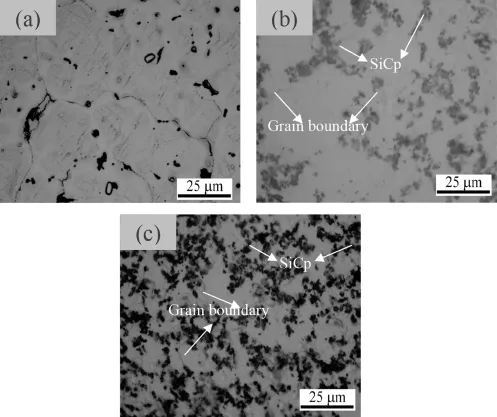
Fig.1.Optical micrographs of as-cast AZ31B alloy and SiCp/AZ31B magnesium matrix composites:(a)AZ31B alloy;(b)3vol.%SiCp/AZ31B composite;(c) 5vol.%SiCp/AZ31B composite.
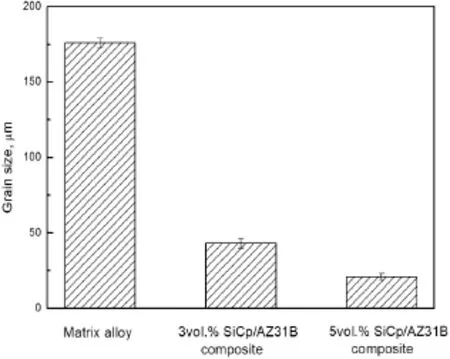
Fig.2.Grain size of as-cast AZ31B alloy and SiCp/AZ31B composites with different volume fractions.
Fig.3 is the SEM micrographs of the SiCp/AZ31B composites.With increasing the volume content of 1 μm-SiCp,the amount of 1-μm SiCp increases.The macro-clusters of particles were not observed,but most particles were segregated along grain boundaries in the micro-scale level,which is the typical necklace particles distribution.This kind of particles segregation is bad to the mechanical properties of the composites.Therefore,it is necessary to redistribute particles and eliminate cast defects using hot deformation.
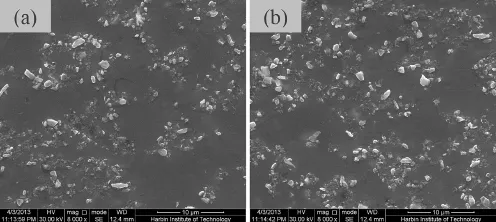
Fig.3.SEM micrographs of as-cast SiCp/AZ31B magnesium matrix composites:(a)3vol.%SiCp/AZ31B composite;(b)5vol.%SiCp/AZ31B composite.

Fig.4.Optical micrographs of AZ31B alloy and SiCp/AZ31B magnesium matrix composites after hot extrusion:(a)AZ31B alloy;(b)3vol.%SiCp/AZ31B composite;(c)5vol.%SiCp/AZ31B composite.
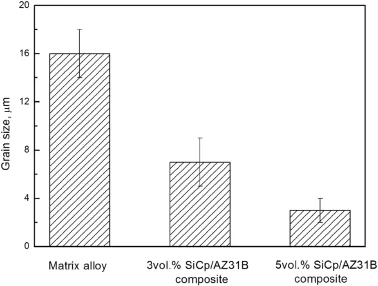
Fig.5.Grain size of AZ31B alloy and SiCp/AZ31B composites after hot extrusion.
Optical micrographs of SiCp/AZ31B magnesium matrix composites after hot extrusion are shown in Fig.4.Fig.5 shows the average grain sizes of the as-extruded AZ31B alloy and SiCp/AZ31B composites.Compared with Figs.1 and 2, much smaller grain size can be found in the as-extruded samples.The resultsofmicrostructure characterization reveal the presence of nearly equiaxed grains in both monolithic alloy and composites,as shown in Fig.4.It illustrates that the DRX takes place during the hot extrusion.Combining Figs.4 and 5,it can be seen clearly that the addition of 1 μm-SiCp has signifcant effect on reducing grain size during hot extrusion.In addition,the effect of 1 μm-SiCp content on the grain size of composites is shown in Fig.4.Compared with the 3 vol.%SiCp/AZ31B composite,the grains in 5 vol.%SiCp/ AZ31B composite are more refned after hot extrusion.The minimum value of grain size obtained in 5 vol.%SiCp/AZ31B composite could be explained as follows:(1)1 μm-SiCp can refne grain size by promoting DRX nucleation during hot extrusion,and the addition of 1 μm SiCp could restrict the grain growth during hot extrusion.(2)The effect of restriction is enhanced as the content of 1 μm-SiCp increased to 5%. Moreover,compared with matrix alloy,the average grain size decreases signifcantly when 1 μm SiCp content is 3 vol.%,but the recrystallization is not full.From Fig.4(C)it also can be seen that the grains around 1 μm-SiC particles and in the deformation zone are smaller,while the grains away from these regions are larger.This indicates that dynamic recrystallization is sensitive to the particle content on a local scale in the composite.Therefore,the effect of particle on promoting DRX nucleation is very weak due to lower particle contents, which results in larger average grain size and asymmetrical grain distribution(as shown in Fig.4(b)and(C)).It is well known that the amount of SiC particles increase with the increasing of volume fraction of micron SiC particulates,thus the DRX nucleation effect of 5 vol.%SiCp/AZ31B composite stronger than that of 3 vol.% SiCp/AZ31B composites. Therefore,the recrystallization becomes much fuller and the minimum value of grain size obtained in the 5 vol.%SiCp/ AZ31B composite.
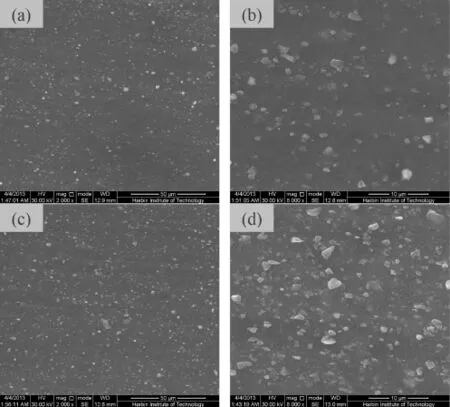
Fig.6.SEM micrographs of SiCp/AZ31B magnesium matrix composites after hot extrusion:(a)3vol.%SiCp/AZ31B composite;(b)high magnifcation of(a);(c) 5vol.%SiCp/AZ31B composite;(d)high magnifcation of(c).
Fig.6 shows the SEM micrographs of the SiCp/AZ31B composites after hot extrusion.The 1 μm-SiC particle clusters which are initially present in some areas in the as-cast composite disappear in the as-extruded composite,as shown in Fig.6(a)and(c),which means that the particle distribution condition in SiCp/AZ31B composite is improved by the application of hot extrusion.And the 1 μm-SiCp distribute relative homogeneous in composite.This can be explained as follows:(1)1 μm-SiC particulates were well dispersed in the matrix during semisolid stirring assisted ultrasonic vibration process(preparation technology).(2)The hot extrusion deformation can impel the matrix alloy fow into the reinforcement clusters(secondary processing).The reason is that the fow velocity of the matrix alloy is faster than that of SiC particles. Therefore,the distribution of SiC particles has been signifcantly improved in the present work.The high magnifcation of 5%SiCp/AZ31B and 3%SiCp/AZ31B composites are shown in Fig.6(b)and(d).It indicates that the good interfacial bonding exists between matrix and SiC particulates in the composite.In addition,the agglomerating regions are not observed in the composite with higher volume fraction of 1 μm-SiC particles,and the image is shown in Fig.6(d).
Fig.7 shows the TEM microstructure of the extruded 5 vol.%SiCp/AZ31B composite.It can be found that a good interfacial bonding exists between the 1 μm-SiCp and the matrix,as shown in Fig.7(a).At higher magnifcation,as shown in Fig.7(b),the interfacial reaction products are not found in the interface between a 1 μm-SiCp and the matrix.
3.2.Mechanical properties
Fig.8 shows the ultimate tensile strength(σUTS),yield strength(0.2%σYS)and elongation to fracture of the AZ31B alloy and the SiCp/AZ31B magnesium matrix composites.It can be seen from Fig.8 that the σUTSand σYSof the AZ31B alloy and the SiCp/AZ31B composites were improved through extrusion process.The increased σYSof the monolithic AZ31B alloy may be attributed to the grain refned by DRX during hot extrusion.For the SiCp/AZ31B composite,the distribution of 1 μm-SiCp in the extrusion condition was improved obviously and the hole between the reinforcement and the matrix was also eliminated in the as-cast composite after hot extrusion. The σUTSand σYSof the SiCp/AZ31B composite are much higher than that of the matrix alloy at the same extrusion condition,as shown in Fig.8.The reasons for this may be that the addition of SiC particles is not only favorable to load transfer and restraining crack extension,but also has a signifcant effect on grain refnement.In addition,it also can be seen from Fig.8 that the σUTSand σYSof the 5 vol.%SiCp/ AZ31B composite were simultaneously enhanced comparing with the AZ31B alloy and the 3 vol.% SiCp/AZ31B composites.
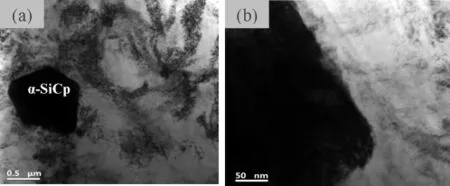
Fig.7.TEM micrographs of SiCp/AZ31B composite:(a)1 μm-SiC particles;(b)interface between 1 μm-SiC particle and matrix alloy.
Some works had indicated that the strength of the particles reinforced composites was signifcantly enhanced because of the improvement of particulates distribution[21].Moreover, the magnesium alloy belongs to hexagonal close packed structure and its yield strength depends on the grain size. According to the classic Hall-Petch relation: σy=σo+Kyd-1/2,whereKyis material constant,σyand d are respectively the yield strength and average grain size,and σois experimentally derived constant[22].The yield strength of the materials is increased with reducing the grain size.The grains of the matrix in the 5 vol.%SiCp/AZ31B composite are obviously refned after hot extrusion(as shown in Fig.4).As a result,the yield strength of the 5 vol.%SiCp/AZ31B composite was enhanced.In addition,the good interfacial bonding between the reinforcement and the matrix after hot extrusion was also contributed to the increase of mechanical properties.
The elastic modulus of AZ31B matrix is improved due to the addition of 1 μm-SiC particulates,as shown in Fig.9. Compared with the 3 vol.%SiCp/AZ31B composite,the elastic modulus of 5 vol.%SiCp/AZ31B composite is more higher.The increased elastic modulus of AZ31B alloy is mainly attributed to the high modulus of introduced 1 μm-SiC particles and good interfacial bonding between 1 μm-SiC particles and matrix.It may be noted that good interfacial bonding between matrix and reinforcement leads to a signifcant enhance in internal stress between 1 μm-SiC particles and matrix resulting in the enhancement of elastic modulus.
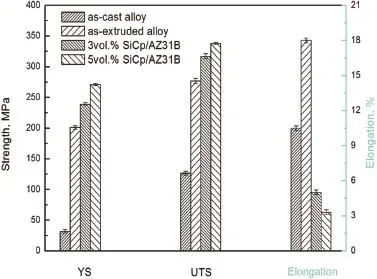
Fig.8.Tensile properties of the AZ31B alloy and as-extruded SiCp/AZ31B composites.
4.Conclusion
Magnesium matrix composites reinforced with 1 μm-SiCp have been successfully fabricated by semisolid stirring assisted ultrasonic vibration method.The microstructures and tensile properties of SiCp/AZ31B composites are experimentally investigated and the main conclusions can be summarized as follows:
(1)The grains of matrix in the SiCp/AZ31B composite exhibit obvious refnement compared with the as-cast AZ31B alloy.Most of the 1 μm-SiCp are distributed along grain boundaries in both 3 vol.%and 5 vol.%SiCp/AZ31B composites while some dispersed 1 μm-SiCp are inside the grains of matrix in the SiCp/AZ31B composites.
(2)Large scale dynamic recrystallization is observed in the extruded 5 vol.%1 μm-SiCp/AZ31B composite with an average grain size of~3 μm.The grain size gradually decreased as the 1 μm-SiCp contents increased to 5 vol.%.
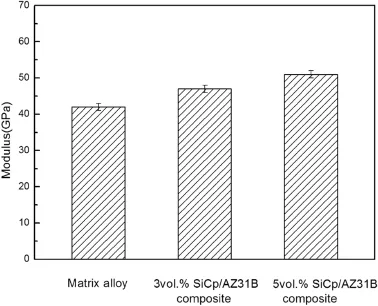
Fig.9.Elastic modulus of composites and AZ31B alloy.
(3)1 μm-SiC particles have signifcant effect on refning grain size through stimulating DRXed nucleation during hot extrusion.The grains around 1 μm-SiCp are smaller,whilethe grains far away from the 1 μm-SiCp particles,which means that dynamic recrystallization is sensitive to the particle content on a local scale in the present composite.
(4)Compared with the extruded AZ31B matrix alloy and 3 vol.%1 μm-SiCp/AZ31B composite,the ultimate tensile strength and yield strength of the 5 vol.%1 μm-SiCp/ AZ31B composite are much higher,while the elongation to fracture is slightly small.The increase of yield strength of the 5 vol.%SiCp/AZ31B composite is due to the uniformity distribution of 1 μm-SiCp,the obvious refnement of the matrix grains and good interfacial bonding between matrix and reinforcement in present study.
Acknowledgments
This work was supported by‘National Natural Science Foundation of China’’(Grant No.51101043),‘Key Project of Science and Technology Department of Heilongjiang Province of China’’(Grant No.GC12A109)and‘the Fundamental Research Funds for the Central Universities’’(Grant No. HIT.NSRIF.201130).
[1]J.E.Gray,B.Luan,J.Alloys Compd.336(2002)88-113.
[2]D.M.Smith,J.A.Eady,L.M.Hogan,D.W.Irwin,Met.Trans.A 22 (1991)575-584.
[3]M.J.Shen,X.J.Wang,M.F.Zhang,Appl.Surf.Sci.259(2012)362-366.
[4]M.Hitchcock,Z.Fan,Mater.Sci.Forum 519(2006)1747-1752.
[5]B.Niroumand,K.Xia,Mater.Sci.Eng.A 283(2000)70-75.
[6]P.J.Uggowitzer,H.Kaufmann,Steel Res.Int.75(2004)525-530.
[7]K.K.Deng,C.J.Wang,J.Y.Shi,Y.W.Wu,K.Wu,Mater.Chem.Phys. 134(2012)581-584.
[8]Z.Fan,G.Liu,M.Hitchcock,Mater.Sci.Eng.A 413(2005)229-235.
[9]X.J.Wang,K.B.Nie,X.S.Hu,Y.Q.Wang,X.J.Sa,K.Wu,J.Alloys. Compd.532(2012)78-85.
[10]R.A.Saravanan,M.K.Surappa,Mater.Sci.Eng.A 276(2000)108-116.
[11]P.Falank,B.Niroumand,Scr.Mater.53(2005)53-57.
[12]D.Apelian,Q.Y.Pan,M.Findon,Die Cast.Eng.48(2004)22-28.
[13]M.C.Flemings,Metal.Mater.Trans.B 22(1991)269-293.
[14]K.B.Nie,X.J.Wang,K.Wu,X.S.Hu,M.Y.Zheng,Mater.Sci.Eng.A 540(2012)123-129.
[15]K.K.Deng,K.Wu,Y.W.Wu,K.B.Nie,M.Y.Zheng,J.Alloys Compd. 504(2010)542-547.
[16]K.B.Nie,X.J.Wang,K.Wu,L.Xu,M.Y.Zheng,X.S.Hu,Mater.Sci.47 (2012)138-144.
[17]K.B.Nie,X.J.Wang,K.Wu,X.S.Hu,M.Y.Zheng,L.Xu,Mater.Sci. Eng.A 528(2011)8709-8714.
[18]K.K.Deng,X.J.Wang,M.Y.Zheng,K.Wu,Mater.Sci.Eng.A 527 (2013)1630-1635.
[19]K.K.Deng,X.J.Wang,W.M.Gan,Y.W.Wu,K.B.Nie,K.Wu, M.Y.Zheng,H.G.Brokmeier,Mater.Sci.Eng.A 528(2011) 1707-1712.
[20]X.J.Wang,X.S.Hu,K.B.Nie,K.K.Deng,K.Wu,M.Y.Zheng,Mater. Sci.Eng.A 545(2012)38-43.
[21]M.J.Shen,X.J.Wang,C.D.Li,M.F.Zhang,X.S.Hu,M.Y.Zheng, K.Wu,Mater.Des.52(2013)1011-1017.
[22]M.J.Shen,X.J.Wang,M.F.Zhang,X.S.Hu,M.Y.Zheng,K.Wu,Mater. Des.54(2014)436-442.
Received 22 December 2014;revised 23 January 2015;accepted 17 March 2015 Available online 11 May 2015
*Corresponding author.Tel./fax:+86 2431530612.
E-mail addresses:smjiekaka@163.com(M.J.Shen),benhuazhang@163. com(B.H.Zhang).
Peer review under responsibility of National Engineering Research Center for Magnesium Alloys of China,Chongqing University.
http://dx.doi.org/10.1016/j.jma.2015.03.001.
2213-9567/Copyright 2015,National Engineering Research Center for Magnesium Alloys of China,Chongqing University.Production and hosting by Elsevier B.V.All rights reserved.
Copyright 2015,National Engineering Research Center for Magnesium Alloys of China,Chongqing University.Production and hosting by Elsevier B.V.All rights reserved.
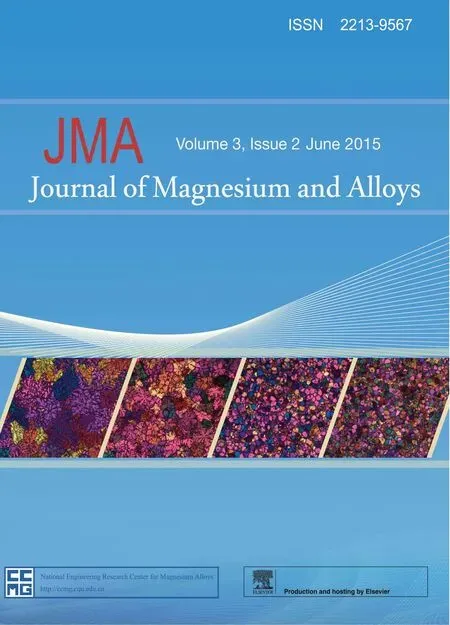 Journal of Magnesium and Alloys2015年2期
Journal of Magnesium and Alloys2015年2期
- Journal of Magnesium and Alloys的其它文章
- GUIDE FOR AUTHORS
- Taguchi optimization of process parameters in friction stir processing of pure Mg
- Processing,microstructure and mechanical properties of bimodal size SiCp reinforced AZ31B magnesium matrix composites
- Magnesium production by carbothermic reduction in vacuum☆
- A comparative corrosion behavior of Mg,AZ31 and AZ91 alloys in 3.5% NaCl solution
- Dynamic compressive property and failure behavior of extruded Mg-Gd-Y alloy under high temperatures and high strain rates
